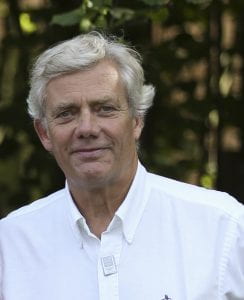A MUSEUM IN MOTION
By Jon M. Erlandson
Executive Director
I’ve had the honor of serving as the museum’s executive director for 15 years now. It’s been quite a journey, involving major expansions of the museum’s facilities and reach, the earning of coveted national accolades, and the weathering of storms brought on by a recent $225,000 cut in annual University of Oregon funding. Despite the funding challenges, the museum continues its long tradition of excellence in research, education, and preservation—and I couldn’t be prouder of our work.
We’ve seen phenomenal growth over the last fifteen years. The Condon Fossil Collection—administratively housed in the university’s geology department beginning in the 1970s—was returned to the museum in 2005. The collection is now regarded as the state’s premier paleontological and geological research collection, offering access to scholars around the world through its digitized catalogs and earning statutory designation in 2017 as the State of Oregon’s repository for fossil collections. In 2009, we added a state-of-the-art anthropological collections center to our main building and expanded our public exhibitions space with a new, 1200 square-foot galleria. In 2014, the new Explore Oregon hall more than doubled our public space and made the UO a destination for international visitors wanting to learn about Oregon’s landscapes, climate, and ecosystems. With the renovation of our Oregon—Where Past is Present hall in 2016, recent installations of the iconic mammoth sculptures in our native plant courtyard, and our adoption in 2018 of the Oregon Folklife Network, it all adds up to an incredibly dynamic and fruitful decade and a half.
This remarkable growth, combined with the museum’s outstanding research, collections stewardship, and educational programming, has resulted in the museum’s full accreditation by the prestigious American Alliance of Museums in 2016 and earned us a 2018 National Medal for Museum and Library Service from the Institute of Museum and Library Services, distinguishing the MNCH as one of the nation’s very best museums.
All along, our success has been fueled by investments from the University of Oregon and by thousands of donors large and small, including grants from the Ford Family Foundation, the Barker Foundation, the Oregon Cultural Trust, the National Science Foundation, the Bureau of Land Management, and many more. I’m deeply grateful for their support.

I’m tremendously proud of our dedicated staff and volunteers, who provide invaluable educational and research experiences to UO students and staff; to our many constituencies in Eugene-Springfield, Lane County, and Oregon; and to visitors and researchers from around the world. I invite you to learn more about their work in this, our first fully digital issue of Fieldnotes.
You’ll read about museum research that’s uncovering critical links between our past, present, and future—like archaeologist Tom Connolly’s ongoing inquiries into Oregon’s deepest cultural past and geologist Greg Retallack’s investigations of Earth’s dynamic paleoclimate. With education at the heart of our mission, we share such research widely, publishing in top science journals and disseminating it through exhibits and public lectures, stories in mainstream media, and the museum’s many digital outlets—outlets that are ever expanding thanks to efforts like those Pamela Endzweig shares in Digital Journeys into the Collections Vault.
You’ll also discover how our Public Programs division is manifesting the museum’s commitment to diversity, inclusiveness, and social justice. For many years, we have collaborated with Native American Tribes to create exhibits that explore and educate around Oregon’s Indigenous past, present, and future. As Ann Craig writes in Museums as Instruments of Change, we are now expanding our focus to include many more of Oregon’s stories—stories from Black communities on campus and around the state, and from LGBTQIA+ communities across the American West.
We find ourselves in a moment in history where white nationalism and homophobia are on the rise—and are even encouraged by some public officials. This fact was driven home shortly after the opening of Racing to Change, when a poster taped on the museum’s front door proclaimed, “It’s OK to be white.” The poster, traced to a white nationalist website that encouraged their placement on university campuses, is a poignant reminder that there is still important work to do in moving our community, our campus, and our world toward inclusion and justice. Exhibits like these offer inspiration to that end and invite dialogue about how we can create needed change.
As a member of the museum family, you are a key part of this dialogue. Thank you for helping us change our world for the better.
NEXT: ANCIENT ARTIFACTS, FRESH CLUES: Research Insights from the Collections Vault

